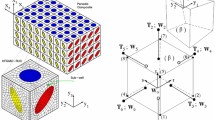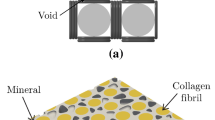Abstract
At its highest level of microstructural organization—the mesoscale or millimeter scale—cortical bone exhibits a heterogeneous distribution of pores (Haversian canals, resorption cavities). Multi-scale mechanical models rely on the definition of a representative volume element (RVE). Analytical homogenization techniques are usually based on an idealized RVE microstructure, while finite element homogenization using high-resolution images is based on a realistic RVE of finite size. The objective of this paper was to quantify the size and content of possible cortical bone mesoscale RVEs. RVE size was defined as the minimum size: (1) for which the apparent (homogenized) stiffness tensor becomes independent of the applied boundary conditions or (2) for which the variance of elastic properties for a set of microstructure realizations is sufficiently small. The field of elastic coefficients and microstructure in RVEs was derived from one acoustic microscopy image of a human femur cortical bone sample with an overall porosity of 8.5%. The homogenized properties of RVEs were computed with a finite element technique. It was found that the size of the RVE representative of the overall tissue is about 1.5 mm. Smaller RVEs (~0.5 mm) can also be considered to estimate local mesoscopic properties that strongly depend on the local pores volume fraction. This result provides a sound basis for the application of homogenization techniques to model the heterogeneity of cortical microstructures. An application of the findings to estimate elastic properties in the case of a porosity gradient is briefly presented.
Similar content being viewed by others
Explore related subjects
Discover the latest articles and news from researchers in related subjects, suggested using machine learning.Abbreviations
- (x, y, z):
-
Orthogonal frame. Bone cross-section is assumed to be in the plane (x, y)
- Z = Z(x, y):
-
Surface acoustic impedance value measured at point (x, y)
- \({\hat Z}\) :
-
Mineralized matrix impedance averaged over the mesodomain matrix area
- p :
-
Porosity
- N (i) :
-
Number of mesodomains in each size group i = 1, . . . , 4
- L (i) :
-
Edge size of the square cross-section of mesodomains in the plane (x, y) in each group i = 1, . . . , 4
- θ :
-
Denotes one random realization of a mesodomain
- L z :
-
Dimension of one mesodomain in direction z
- C(θ):
-
Apparent stiffness tensor for one mesodomain realization
- C t (θ):
-
Lower bound of the apparent stiffness tensor calculated with SUBC for one mesodomain realization
- C d (θ):
-
Upper bound of the apparent stiffness tensor calculated with KUBC for one mesodomain realization
- h :
-
Characteristic size of the finite element mesh
- E, G and ν:
-
Apparent engineering elastic moduli, respectively, Young modulus, shear modulus and Poisson ratio
- W :
-
Denotes any of the apparent engineering moduli
- W t , W d :
-
Denotes any of the apparent engineering moduli obtained with either SUBC or KUBC, respectively
- δ(θ), d W (θ):
-
Measures of the interval between the bounds of the apparent elastic behavior for one mesodomain realization
- \({\hat \delta_i, \hat d_{W ;i}}\) :
-
Mean values of δ and d W in each quartile i = 1, . . . , 4
- \({\hat W (L)}\) :
-
Mean of the engineering modulus W of mesodomains of size L
- D W (L):
-
Standard deviation of the engineering modulus W of mesodomains of size L
- \({\epsilon_W}\) :
-
Absolute uncertainty on the mean value of W
- \({L = L_{{\rm RVE}} (\epsilon_W; W)}\) :
-
Size of RVE (Definition 2) for modulus W for a prescribed precision of \({\epsilon_W}\)
- W 0;L (p):
-
Linear regression model for property W as a function of porosity, calculated for mesodomains of size L
References
Aoubiza B, Crolet JM, Meunier A (1996) On the mechanical characterization of compact bone structure using the homogenization theory. J Biomech 29(12): 1539–1547
Baron C, Grimal Q, Talmant M, Laugier P (2008) Investigation of the porous network as a determinant of the overall stiffness of cortical bone: Mori-Tanaka model vs. ultrasound propagation. In: ASA, J Acoust Soc Am vol 123. Paris, p 3514
Baron C, Talmant M, Laugier P (2007) Effect of porosity on effective diagonal stiffness coefficients (cii) and elastic anisotropy of cortical bone at 1 mhz: a finite-difference time domain study. J Acoust Soc Am 122(3): 1810
Cooper DM, Thomas CDL, Clement JG, Turinsky AL, Sensen CW, Hallgrimsson B (2007) Age-dependent change in the 3d structure of cortical porosity at the human femoral midshaft. Bone 40(4): 957–965
Cowin SC (2001) Bone mechanics handbook, vol 1, 2nd edn. CRC Press, Boca Raton
Crolet JM, Aoubiza B, Meunier A (1993) Compact bone: numerical simulation of mechanical characteristics. J Biomech 26(6): 677–687
Currey J (2002) Bones: structure and mechanics. Princeton Academic Press, Princeton
Dong XN, Guo XE (2006) Prediction of cortical bone elastic constants by a two-level micromechanical model using a generalized self-consistent method. J Biomech Eng Trans Asme 128(3): 309–316
François M, Geymonat G, Berthaud Y (1998) Determination of the symmetries of an experimentally determined stiffness tensor: application to acoustic measurements. Int J Solids Struct 35(31–32): 4091–4106
Grimal Q, Raum K, Gerisch A, Laugier P (2008) Derivation of the mesoscopic elasticity tensor of cortical bone from quantitative impedance images at the micron scale. Comput Methods Biomech Biomed Eng 11(2): 147–157
Grimal Q, Raum K, Gerisch A, Laugier P (2009) About the determination of the representative volume element size in compact bone. In: Congrès Français de Mécanique. Marseille
Hellmich C, Barthelemy J, Dormieux L (2004) Mineral-collagen interactions in elasticity of bone ultrastructure—a continuum micromechanics approach. Eur J Mech A Solids 23(5): 783–810
Hellmich C, Ulm FJ (2004) Can the diverse elastic properties of trabecular and cortical bone be attributed to only a few tissue-independent phase properties and their interactions?. Biomech Model Mechanobiol 2: 219–238
Hill R (1963) Elastic properties of reinforced solids: some theoretical principles. J Mech Phys Solids 11: 357
Huet C (1990) Application of variational concepts to size effects in elastic heterogeneous bodies. J Mech Phys Solids 38(6): 813–841
Jeulin D (2001) Caractérisation morphologique et modèles de structures aléatoires. In: Homogénéisation en mécanique des matériaux, vol 1. Hermès, Paris, pp 95–132
Kanit T, Forest S, Galliet I, Mounoury V, Jeulin D (2003) Determination of the size of the representative volume element for random composites: statistical and numerical approach. Int J Solids Struct 40(13–14): 3647–3679
Kanit T, N’Guyen F, Forest S, Jeulin D, Reed M, Singleton S (2006) Apparent and effective physical properties of heterogeneous materials: representativity of samples of two materials from food industry. Comput Methods Appl Mech Eng 195(33–36): 3960–3982
Lakshmanan S, Bodi A, Raum K (2007) Assessment of anisotropic tissue elasticity of cortical bone from high-resolution, angular acoustic measurements. IEEE Trans Ultrason Ferroelectr Freq Control 54(8): 1560–1570
Martin RB, Burr DB, Sharkey NA (1998) Skeletal tissue mechanics, vol 1, 1st edn. Springer, New York
Ostoja-Starzewski M (2008) Microstructural randomness and scaling in mechanics of materials. Chapman and Hall, CRC, London
Pahr D, Zysset P (2008) Influence of boundary conditions on computed apparent elastic properties of cancellous bone. Biomech Model Mechanobiol 7(6): 463–476
Parnell WJ, Grimal Q (2009) The influence of mesoscale porosity on cortical bone anisotropy. Investigations via asymptotic homogenization. J R Soc Interf 6: 97–109
Raum K (2008) Microelastic imaging of bone. IEEE Trans Ultrason Ferroelectr Freq Control 55(7): 1417–1431
Raum K, Cleveland R, Peyrin F, Laugier P (2006) Derivation of elastic stiffness from site-matched mineral density and acoustic impedance maps. Phys Med Biol 51(3): 747–758
Raum K, Reisshauer J, Brandt J (2004) Frequency and resolution dependence of the anisotropic impedance estimation in cortical bone using time-resolved scanning acoustic microscopy. J Biomed Mater Res A 71(3): 430–438
Ren ZY, Zheng QS (2002) A quantitative study of minimum sizes of representative volume elements of cubic polycrystals—numerical experiments. J Mech Phys Solids 50(4): 881–893
Sab K (1992) On the homogenization and the simulation of random materials. Eur J Mech A Solids 11: 585–607
Saied A, Raum K, Leguerney I, Laugier P (2008) Spatial distribution of anisotropic acoustic impedance assessed by time-resolved 50-MHz scanning acoustic microscopy and its relation to porosity in human cortical bone. Bone 43(1): 187–194
Saporta G (1990) Probabilités, analyses des données et statistiques. Technip, Paris
Sevostianov I, Kachanov M (2000) Impact of the porous microstructure on the overall elastic properties of the osteonal cortical bone. J Biomech 33(7): 881–888
Soize C (2008) Tensor-valued random fields for meso-scale stochastic model of anisotropic elastic microstructure and probabilistic analysis of representative volume element size. Probab Eng Mech 23(2–3): 307–323
Torquato S (2002) Random heterogeneous materials. Interdisciplinary applied mathematics; mechanics and materials. Springer, New York
Zohdi T, Wriggers P (2005) Introduction to computational micromechanics. Lecture notes in applied computational mechanics. Springer, Berlin
Author information
Authors and Affiliations
Corresponding author
Rights and permissions
About this article
Cite this article
Grimal, Q., Raum, K., Gerisch, A. et al. A determination of the minimum sizes of representative volume elements for the prediction of cortical bone elastic properties. Biomech Model Mechanobiol 10, 925–937 (2011). https://doi.org/10.1007/s10237-010-0284-9
Received:
Accepted:
Published:
Issue Date:
DOI: https://doi.org/10.1007/s10237-010-0284-9
Keywords
Profiles
- Alf Gerisch View author profile




